
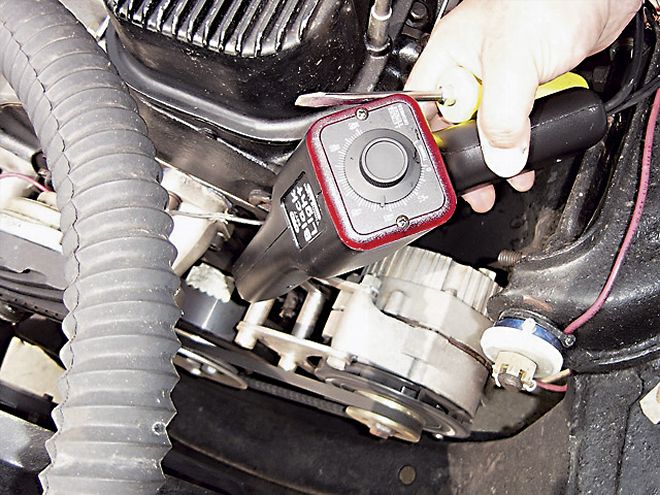 Whether you're tuning for power or fuel efficiency, igniting the air/fuel mixture at the correct time is critical. A good timing light is your first step to getting your engine where it needs to be.
Whether you're tuning for power or fuel efficiency, igniting the air/fuel mixture at the correct time is critical. A good timing light is your first step to getting your engine where it needs to be.
Improving fuel economy or gaining horsepower means making the engine more efficient. Fuel economy or maximum power is only obtainable when the correct air/fuel mixture or ratio (a richer mixture for power and a leaner mixture for economy) is ignited by the ignition system at the correct time. In this way, all the energy of the richer air/fuel mixture is converted to power; similarly, the leaner mixture gains fuel economy because its charge is burned completely.A high-performance engine will only perform at its best when the initial timing and the ignition advance curve are tailored to suit the engine, the fuel, the owner's driving style, usage, etc. High-performance carburetors, intake manifolds, cylinder heads, camshafts, and other tuning components are all dependent upon correct ignition timing; if the spark is not delivered at the proper time to the combustion chamber, the quest for power or economy is for nothing.
AIR/FUEL RATIOS
Optimum air/fuel ratios are usually calculated by an engine dynamometer. These ratios vary not only when tuning for power or economy, but also from engine to engine, load conditions, altitude, etc. For unleaded fuel at sea level, the stoichiometric value (the ideal ratio of air and fuel that is required to provide the complete burn) is 14.7:1; that is, 14.7 lbs of air to 1 lb of fuel. However, because of operating losses in the induction system due to intake runner and cylinder wall wetting, a more realistic air/fuel ratio for maximum horsepower will be a richer 12.2:1 to 13.5:1 and leaner for maximum economy. Rich mixtures are safer due to their cooler charge and slightly longer burn time. Once established, an air/fuel ratio meter, like the Innovate Motorsports LM1 Air/Fuel Ratio Meter, could help monitor the figures.
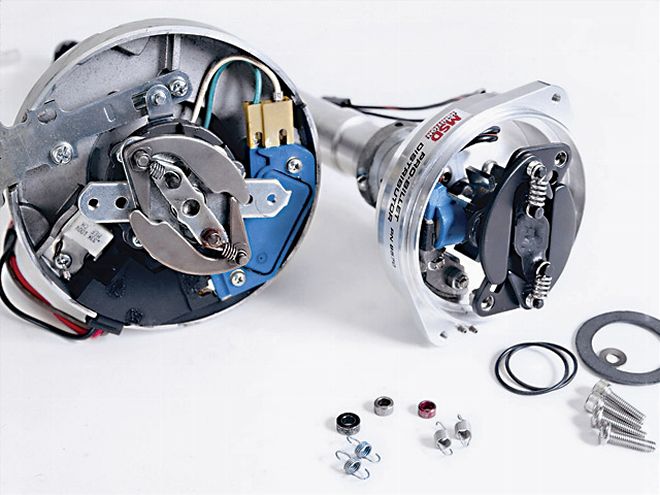 Advance curves can be tuned with bushings and springs. The bushings limit the amount of ignition advance, and the springs control the rate of advance.
Advance curves can be tuned with bushings and springs. The bushings limit the amount of ignition advance, and the springs control the rate of advance.
IGNITION TIMING
Igniting the correct air/fuel ratio at the correct time is the responsibility of the ignition system. Ignition timing consists chiefly of three parts: initial timing, timing advance or curve, and total timing. Checking and adjusting these elements of timing for maximum power and efficiency are fairly easy and inexpensive. It's also satisfying to uncover untapped power in a performance engine, knowing that those gains can improve the performance of other components. Certainly, a carburetor cannot perform to its optimum unless the ignition timing is correct. The basic rule of carburetor tuning is ignition first. Once the ignition advancing mechanism is correct, the air/fuel mixture can be tuned for improved power or fuel efficiency.
INITIAL TIMING
The chief function of initial timing is to provide a clean idle and crisp throttle response. One of the best guides to determine the initial ignition timing of V-8 engines can be found in the Barry Grant Inc. catalog or on their Web site under the Demon Carburetor Guide. Typically, they recommend 10 to 12 degrees of initial timing when the duration of the camshaft is less than 220 degrees @ 0.050-inch of valve lift; 14 to 16 degrees of initial timing with a camshaft duration of less than 240 degrees @ 0.050-inch; and 18 to 20 degrees of initial timing when the camshaft duration is less than 260 degrees @ 0.050-inch of valve lift. To check initial timing, clean the TDC (top dead center) line or indentation on the harmonic balancer at the front of the engine and, if necessary, identify it with chalk or crayon to make it more visible. Run the engine at idle, aim a timing light at the harmonic balancer, and note the initial timing of ignition to the number-one spark plug. To adjust the initial timing, slightly loosen the bolt that secures the distributor to the engine, and slowly rotate the distributor body until the initial timing agrees with the appropriate figures mentioned above. Retighten the distributor to the engine. To verify that the harmonic balancer and the pointer are correctly aligned on a new or rebuilt engine, bring the number-one piston to TDC on the compression stroke and confirm that the indentation on the harmonic balancer and the pointer are in alignment on zero degrees.
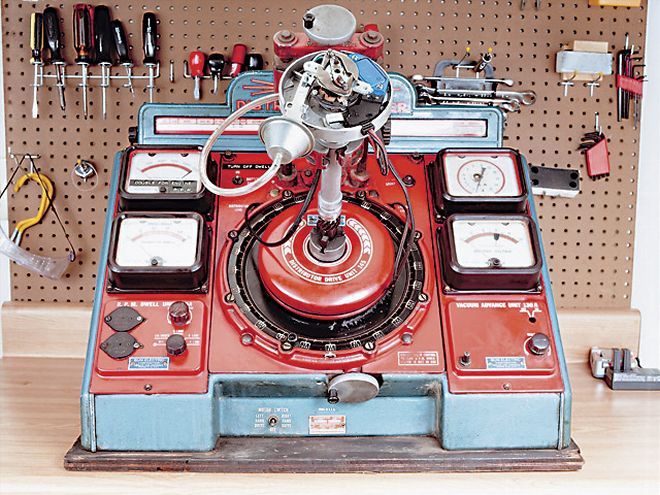 Although not as commonly used today as it once was, a distributor tester is a valuable resource to identify the amount of mechanical and vacuum advance as well as the rate at which it occurs.
Although not as commonly used today as it once was, a distributor tester is a valuable resource to identify the amount of mechanical and vacuum advance as well as the rate at which it occurs.
TIMING ADVANCE
As engine rpm increases, it is necessary to advance the ignition timing. If not, the burning process in the combustion chamber would take longer than the speeding piston would permit, resulting in an incomplete burn. To give the burning process a head start, an ignition advance mechanism is provided within the distributor. It is activated by engine revs and by the centrifugal force generated through the weights and springs within the distributor. Consequently, as the engine revs increase so, too, does the advancement of the ignition.The ignition advance mechanism operates either as a mechanical/centrifugal advance only or as a mechanical/centrifugal advance with vacuum assistance. Mechanically operated distributors are usually associated with high-performance and racing engines; vacuum-assisted distributors are chosen for their improved fuel economy and exhaust emissions. Vacuum timing is controlled by the vacuum or depression in the intake manifold and flourishes under light loads. Under acceleration, however, the vacuum in the manifold weakens as the throttle plates of the carburetor open and the ignition advance reverts to the control of the mechanical/centrifugal mechanism. With either design, the timing advance mechanism should not begin advancing before 1,000 rpm and, usually, full advance will have occurred before 3,500 rpm. Too much advance while the engine speed is low can cause harmful pinging or detonation; too little advance as engine revs increase will demonstrate a lack of power. The rate at which the timing advance occurs is referred to as the advance curve.
The advance curve used on most production engines and on aftermarket distributors is designed to allow an engine to operate under a wide range of conditions (flat terrain, hilly terrain, towing, fluctuations in the quality of fuel, etc). As a consequence, ignition advance curves tend to be conservative for general use. But for hot rods and other specialized uses, the advance curve can be easily altered and tuned by specialists like John Bishop's Hot Rod Tuning of Burlingame, California. According to Bishop, the best way of checking the advance curve of either the vacuum or mechanical distributor is on a distributor tester. These test machines are not as fashionable in tuning shops today as they previously were, but, nonetheless, they're still in use and perform an invaluable service for hot rod owners. In the 1960s, when most tuning shops possessed a distributor tester, hot rodders gained most of their power advantages by having their ignition advance curves modified. Today, the ignition advance curves on most hot rods remain unchecked and are taken for granted; they may function close to their optimum, but, then again, they may not. Obviously, checking the advance curve on a distributor tester is a lot less stressful than on an engine. The tester can check the distributor at 6,000 engine rpm, or more, without involving the engine. Note: The advance readings provided by a distributor tester have to be doubled as the distributor turns at half the engine speed; thus, a reading of 12 degrees advance @ 1,750 distributor rpm equates to 24 degrees @ 3,500 engine rpm.
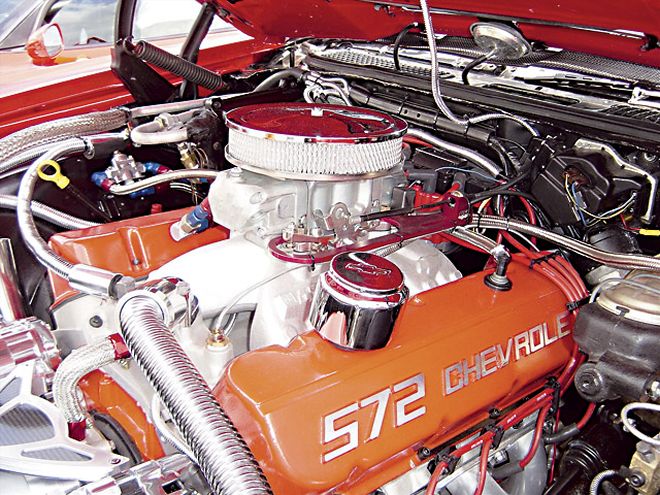 If you're going to run a race-inspired intake manifold or camshaft on the street, you'll need a carb such as the Mighty Demon, which supplies a finer atomized air/fuel mixture at part-throttle to allow the engine to run properly.
If you're going to run a race-inspired intake manifold or camshaft on the street, you'll need a carb such as the Mighty Demon, which supplies a finer atomized air/fuel mixture at part-throttle to allow the engine to run properly.
The alternative method of checking the mechanical and vacuum advance curve, according to Bishop's Tuning Shop, is with the distributor fitted in the engine. If the engine has a degreed harmonic balancer, the amount of timing advance can be observed by using a standard timing light. If not, use a dial-back style of timing light or an MSD tape. The MSD timing tapes adhere to the harmonic balancers and are available in diameters of 5.250 to 8.00 inches.Begin the procedure by disconnecting the distributor's vacuum hose from the carburetor and capping the open port. Then, observe the amount of advance of the mechanical advance mechanism in 250-rpm increments from idle until it stops advancing. To vary the vacuum supplied to the vacuum advance mechanism, Bishop's uses a hand vacuum pump and an OTC/SPX Advance Timing Light. This allows them to read the amount of advance generated by different amounts of vacuum from 1 to 23 inches. When choosing an ignition advance curve, the specialist will consider such factors as the octane of the fuel, compression ratio, design of the combustion chamber, engine speed, engine load, engine temperature, air temperature, the weight of the vehicle, and the driving style of the operator. When the amount of advance timing from both the mechanical and vacuum advance mechanisms is added to the initial timing, we have total timing.
TOTAL TIMING
As cylinder head designs progressed, the amount of total ignition timing necessary decreased. The earlier style of the small-block Chevrolet engine, for example, needs 36 to 40 degrees of total ignition timing; in contrast, modern small-block Chevrolet engines operate between 28 and 32 degrees. Of course, initiating a spark 28 or 30 degrees before the piston reaches top dead center wastes a lot less energy than igniting the charge at 40 degrees before TDC. Yet, while cruising at light throttle loads, igniting the charge early is exactly what occurs on a fuel-efficient hot rod with vacuum advance ignition timing. Leaner air/fuel mixtures, those that occur during idle and light throttle loadings, have a shorter burn time than rich air/fuel mixtures.These leaner, low-load mixtures are the result of slower air velocities, which cause lower volumetric efficiencies (poorer cylinder filling). In addition, the scavenge effect in the exhaust port needed to expel the spent exhaust gases from the combustion chamber dilutes the oxygen levels with unburned fuel and slows the burn rate. To exploit this leaner condition, the vacuum advance mechanism "adds timing." Typically, early small-block Chevy and most small-block Ford engines with a compression ratio of 9.5:1 will, in most cases, respond well to 36 degrees of ignition timing (initial timing plus the mechanical advance), plus a further 10 degrees from the vacuum advance mechanism, making a total timing of 46 degrees.
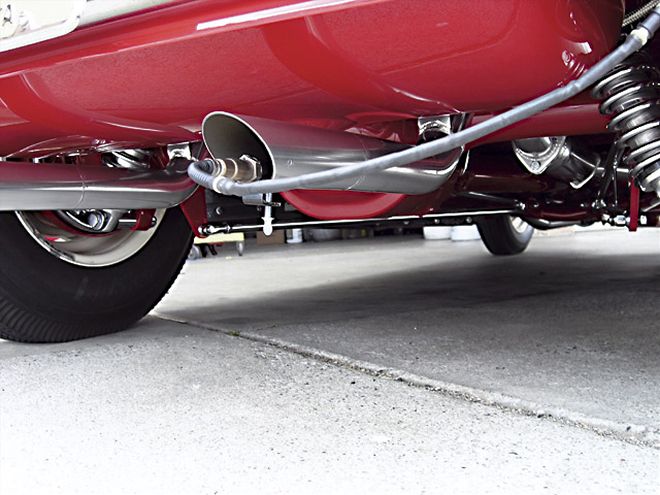 Checking the air/fuel ratios at the tailpipe will also give you valuable info when fine-tuning the ignition timing. A good tune-up shop should have the equipment necessary to get these readings.
Checking the air/fuel ratios at the tailpipe will also give you valuable info when fine-tuning the ignition timing. A good tune-up shop should have the equipment necessary to get these readings.
Adding timing with a vacuum advance is also used to overcome a fault in hot rods with street engines fitted with race-designed induction equipment and performance cylinder heads. Air gap-style intake manifolds are not designed to transfer heat from the cylinder heads, but instead their high-rise runners feed and thrive on high-revving race engines. Naturally, when used in an incompatible setting, the absence of heat and the consequent poor vaporization of the air/fuel mixture cause hesitation and poor drivability at lower engine rpm.One way of addressing these troubles is to use an ignition advance curve that allows an initial timing of 16 to 18 degrees combined with a highly tunable race-inspired carburetor, such as a Mighty Demon. This carburetor supplies a finer atomized air/fuel mixture at part-throttle and allows an engine with a race-inspired intake manifold or camshaft to run properly. An engine with a performance camshaft will also respond well to more initial timing because, at lower engine speeds, the air velocities are reduced due to valve overlap and the air/fuel mixture is poor. Therefore, advancing the initial timing provides longer time for this poorer mixture to burn in the cylinder; the same applies to supercharged applications. When the initial timing is altered, the amount of total ignition advance must be checked and adjusted on both mechanical and vacuum distributors to ensure the maximum setting is not exceeded. If not, engine damage will result if the total advance is excessive for the engine.
DOING THE NUMBERS
The "hot rod advance curve" used mostly on a 9:1 engine with a mild camshaft (duration less than 220 degrees at 0.050-inch of valve lift) is 10 to 12 degrees initial timing plus 22 to 24 degrees of additional advance from the mechanical advance mechanism. In most cases, full advance (32 to 36 degrees) will have occurred before 3,500 rpm. An engine with camshaft duration of above 240 degrees, but less than 260 degrees of duration @ 0.050-inch valve lift, will respond well to 18 degrees of initial timing; however, the total timing will remain the same (32 to 36 degrees). The ideal ignition timing for power occurs just before the point where detonation or pinging takes place. Correctly timed ignition will cause peak cylinder pressures to occur around 12 to 15 degrees after TDC. If the peak cylinder pressure is reached too early, power will be lost as the piston fights to compress the burning air/fuel mixture. Detonation may also occur, which can lead to engine failure. Conversely, if peak pressure is reached after the 12 to 15 degree range, energy is wasted and dispersed through the exhaust system as heat.
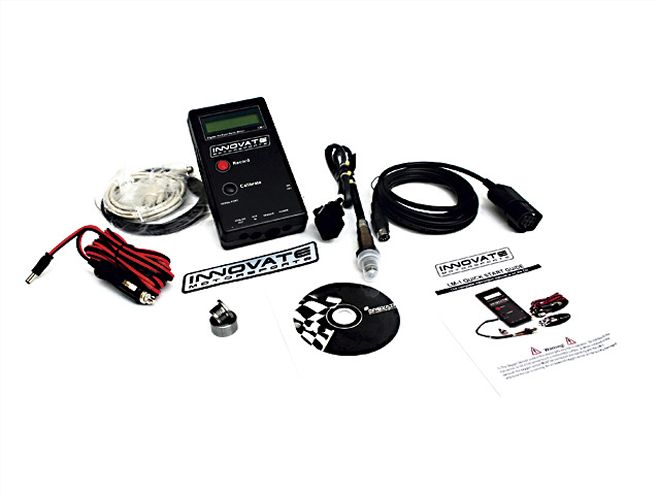 The Innovate Motorsports LM-1 Air/Fuel Ratio Meter is a valuable tool when it comes time to adjust carb jetting and ignition timing. The meter provides data on exactly how rich or lean an engine is running at any load. Its self-calibrating circuitry also compensates for changes in temperature, altitude, and sensor condition.
The Innovate Motorsports LM-1 Air/Fuel Ratio Meter is a valuable tool when it comes time to adjust carb jetting and ignition timing. The meter provides data on exactly how rich or lean an engine is running at any load. Its self-calibrating circuitry also compensates for changes in temperature, altitude, and sensor condition.
POINTS TO REMEMBER
Retarded or insufficient timing advance will cause an engine to lack power. Conversely, excessive timing advance can also cause a lack of engine power, but, worse, it can lead to overheating and costly damage from detonation. In many cases, the advance curve of a distributor may not be appropriate for today's fuels or the engine combination that is being used. Many performance replacement distributors exhibit very slow advance curves; however, they're usually supplied with an assortment of bushings and springs to facilitate a more rapid curve.The bushings regulate the amount of timing advance; the springs regulate the rate of timing advance. In conclusion, whether the distributor is an original or a performance replacement unit, it's prudent to have it checked to ensure its proper operation and its suitability for the vehicle. A rich air/fuel mixture that produces its maximum power at 12.5:1 requires less advance timing than a leaner air/fuel mixture of 14.0:1 (a typical hot rod AFR at cruising speeds). In the former example, extra power is realized by the richer air-fuel mixture; in the latter, economy is achieved by the action of the vacuum advance mechanism.The reason an engine can exploit the additional spark advance provided by the vacuum advance mechanism is because the leaner air/fuel mixture, occurring at light throttle cruising speeds, takes longer to burn than a richer air/fuel power mixture. In most cases, when using a "hot rod mechanical advance curve," the desired amount of additional advance generated by the vacuum advance mechanism is around 10 degrees. According to Bishop's Tuning Shop, this additional 10 degrees of advance timing should occur with 10 inches of vacuum or more. When tuning for economy or power, here are some of the suggested parts and tools of reference:
Mighty Demon carburetor Dial-back timing lights from OTC Ignition scope (OTC Solarity) LM-1 Air/Fuel Ratio Meter from Innovate r XD-1 in-dash air/fuel mixture gauge Exhaust gas analyzer OTC Solarity Gas